Permaculture companion plants for Kale
| Image | Name | Data | Description | Actions |
|---|---|---|---|---|
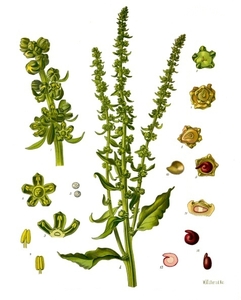
|
Beet |
4-8
Biennial
Full sun
Moist
Light (sandy), Medium, Heavy (clay)
Deciduous
0.9
True
Leaves, Root
Seed - direct sow, Seed - transplant
2 weeks before last frost
https://en.wikipedia.org/wiki/beta_vulgaris
Chenopodiaceae
Rübe
https://pfaf.org/user/plant.aspx?latinname=beta vulgaris craca
6.0-6.8
10°c (50°f)
5-12 days
1.5 cm
20cm
45-65
Beta vulgaris subsp. vulgaris Conditiva Group, beetroot
6-8 weeks before last frost
2-3 weeks before last frost, 6-8 weeks before the first frost
2-3 years
0.25
|
Beet (Beta vulgaris vulgaris), also known as garden beet, red beet, or table beet, is a plant that is native to the Mediterranean region. It is a biennial plant that typically grows to a height of 0.5-1.5 feet and has dark green leaves that are long and rounded, with a smooth or slightly hairy texture. The stem is usually light green in color, and the plant produces small, white or yellow flowers. Beet plants grow best in well-drained soil that is rich in organic matter, and they prefer full sun to partial shade. To cultivate beets successfully, a grower will need to keep the soil moist and weed-free, and may need to thin the plants to allow for proper growth. Beets are edible, and the most commonly eaten part of the plant is the root, which is typically red or purple in color. The leaves of the plant can also be eaten, and are often used in salads. Beets can be stored after harvest by washing and trimming the roots, and then storing them in a cool, dark place. Beets have a number of uses, both culinary and non-culinary. In the kitchen, beets can be cooked in a variety of ways, including boiling, roasting, and grilling. They can also be used to add color and flavor to salads, soups, and stews. In addition to their culinary uses, beets have a number of medicinal properties and have been used to treat a variety of ailments, including indigestion, constipation, and inflammation. Beets are also valuable for their ability to improve soil fertility, as their leaves and roots contain high levels of nitrogen and other nutrients. They can be used as a natural fertilizer, and can also be used as a mulch or as a ground cover to help control weeds. Beets are not particularly attractive to wildlife, but they can provide food for a variety of animals, including deer, rabbits, and birds. Overall, beets are a versatile and valuable plant that is widely cultivated by gardeners and farmers for their edible roots and leaves, as well as for their potential uses in medicine and agriculture. ### Links [How to Grow Beets @ Harvest to Table](https://harvesttotable.com/how_to_grow_beets/) |
Show
Edit |

|
Allium cepa |
3-9
Annual
Full sun
Moist
Light (sandy), Medium
0.6
Herbs
Flowers, Leaves, Root, Seed
Seed - direct sow, Seed - transplant
https://en.wikipedia.org/wiki/Onion
Garden onion
Alliaceae
Zwiebel
https://pfaf.org/User/Plant.aspx?LatinName=Allium cepa
50°f, 10°c
Seed indoors 6 weeks before transplanting in the garden
2-6 inches
6.0-7.0
Allium
Turkmenistan
Algeria, Argentina Northeast, Arkansas, Baltic States, Bangladesh, Belarus, Bulgaria, California, Cambodia, Canary Is., Central European Rus, China North-Central, China South-Central, China Southeast, Colombia, Cuba, Czechoslovakia, Dominican Republic, East Aegean Is., East European Russia, East Himalaya, Ecuador, Egypt, Ethiopia, Fiji, France, Galápagos, Guinea-Bissau, Haiti, Illinois, India, Iraq, Italy, Jamaica, Kansas, Kentucky, Kirgizstan, Korea, Krym, Libya, Louisiana, Madeira, Manchuria, Mauritania, Mexico Central, Mexico Gulf, Mexico Northeast, Mexico Southeast, Mexico Southwest, Minnesota, Montana, Morocco, New York, Niue, North European Russi, Northwest European R, Oregon, Pakistan, Puerto Rico, Seychelles, South European Russi, Spain, Tadzhikistan, Texas, Thailand, Tibet, Tonga, Trinidad-Tobago, Ukraine, Uzbekistan, Vermont, Washington, West Himalaya, West Siberia, Wisconsin, Xinjiang, Yugoslavia
Spring or fall
0.3
https://powo.science.kew.org/taxon/urn:lsid:ipni.org:names:527795-1
Cosmetic, Dye, Hair, Polish, Rust
true
|
Onion (Allium cepa) is a plant species in the family Amaryllidaceae. It is native to central Asia and is commonly grown as a vegetable in many parts of the world. Onions are biennial plants, meaning they typically have a two-year life cycle. In the first year, the onion forms a small, rounded bulb with thin, papery skin. In the second year, the onion will produce a tall stem with hollow, elongated leaves and a small, spherical flower head. Onions are typically grown for their bulbs, which are used as a food ingredient in many dishes. The bulbs can vary in size and shape, depending on the variety, but are generally spherical or oblong in shape and range in size from about 2-4 inches in diameter. Onions are commonly differentiated by their color, which can range from white to yellow to red. Onions prefer well-drained soil that is rich in organic matter. They should be planted in a sunny location and will benefit from regular watering, especially during dry periods. Onion bulbs can be harvested when they reach the desired size, typically after about 100-150 days of growth. To store onions, they should be dried and cured in a cool, dry place for about two weeks before being placed in a mesh bag or other breathable container. Onions are edible and are commonly used as a food ingredient in many dishes. The bulbs are the most commonly used part of the plant, but the leaves and stems can also be used in cooking. Onions have a pungent, spicy flavor and are often used to add flavor to soups, stews, and other dishes. Onions can be stored for several months if properly dried and cured. In addition to their use as a food ingredient, onions have also been used for their medicinal properties. They have been used to treat a variety of ailments, including coughs, colds, and respiratory infections. Onions are also sometimes used as a natural fertilizer, due to the high levels of sulfur and other nutrients they contain. Onions are not known to provide significant value to wildlife. They are not a preferred food source for most animals and do not provide any significant habitat value. However, some insects, such as the onion maggot, can be pests of onion crops. |
Show
Edit |
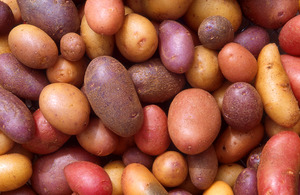
|
Potato |
3-10
Full sun
Moist
Light (sandy), Medium, Heavy (clay)
1.0
0.5
Perennial
12 inches
Seed - direct sow
April
Root
Irish potato, Andigena
Kartoffel
Solanaceae
Argentina Northwest, Argentina South, Bolivia, Chile Central, Chile North, Chile South, Colombia, Ecuador, Peru, Venezuela
Assam, Bangladesh, Belgium, Dominican Republic, East European Russia, East Himalaya, France, Great Britain, Haiti, Hawaii, Illinois, India, Ireland, Laos, Maryland, Minnesota, New York, South European Russi, Tadzhikistan, Uzbekistan, Vietnam, Zaïre
https://en.wikipedia.org/wiki/Potato
https://pfaf.org/User/Plant.aspx?LatinName=Solanum tuberosum
https://powo.science.kew.org/taxon/urn:lsid:ipni.org:names:821337-1
Rutin
Alcohol, Biomass, Cleanser, Cosmetic, Polish, Starch
true
|
Potato (Solanum tuberosum) is a herbaceous perennial plant that is native to the Andean region of South America. It is a member of the nightshade family (Solanaceae) and is closely related to other nightshades such as tomatoes, eggplants, and bell peppers. The potato plant has a bushy growth habit and can grow to heights of 30-150 cm depending on the variety. The leaves are large, heart-shaped, and alternate along the stem. The flowers are white or purple and have five petals. The plant produces small green berries that contain numerous seeds, but most varieties of potatoes are propagated vegetatively from tubers rather than from seeds. The edible part of the potato plant is the tuber, which is an underground stem that is modified for food storage. Potatoes come in a wide range of shapes, sizes, and colors including white, yellow, red, and purple. The size and shape of the tuber depends on the variety, with some varieties producing small, round tubers and others producing large, elongated tubers. Potatoes grow best in well-draining, fertile soils in a sunny location with a pH of 4.5-6.0. They require regular watering and should be planted in a location with good air circulation to prevent fungal diseases. Potatoes are typically planted from tubers that have been treated with a fungicide to prevent disease and are spaced 25-30 cm apart in rows that are 75-90 cm apart. The tubers will begin to form in the soil around 6-8 weeks after planting and can be harvested when they reach the desired size. Potatoes are a versatile and nutritious food source that is rich in vitamins, minerals, and fiber. The tubers are eaten cooked, baked, fried, or mashed, and the leaves and flowers of the plant can also be eaten. Potatoes can be stored in a cool, dry, and dark place for several months. Potatoes have a number of uses beyond their value as a food source. The tubers can be used as seed potatoes for planting, and the leaves and stems can be used as a natural insecticide or as mulch in the garden. In some parts of the world, potatoes are also used for their medicinal properties. Potatoes are a valuable food source for a variety of wildlife, including deer, rabbits, and squirrels. The flowers of the potato plant are also a source of nectar for bees and other pollinators. |
Show
Edit |

|
Zea mays |
2-11
Full sun
Moist
Light (sandy), Medium, Heavy (clay)
2
0.66
Annual
Fast
true
Pollen, Seed, Stem
Oil, Coffee
Maize, corn, abado, able, aburow, agbado, awasi, awi, bara-jowar, bhutta, blefo, bli, buta, chujak, goinjol, gomdhan, igbado, jagung, janar, jonar, junri, kaaba, keto, kolkoti, kon, kono, kukri, maka, makai, makka jonnalu, makka-cholam, makka, makkai, makkari, makoi, masara agwado, massara, mekkejola, milho, mokka-janna, musukojola, naham, nyo, oka, oksusu, shaa, sil ni vavalagi, ta-mank, yu shu shu, ai, amylum maydis, awási, aya, corn oi, 6 corn oil (unhydrogenated), corn silk, corn starch, corn syrup solids, corn|iringu, dent corn, dura shami, field corn, flint corn, gangnaengi, granoturco, indian corn, maidis stigma, mais, maiz, aceite, maize oil, refined, maize starch, majs, maydis amylum, maydis oleum raffinatum, maydis stigma, maíz, aceite refinado, maîs, maïs, ogsusu, oleum maydis, pelos de elafe, pod corn, popcorn, refined maize oil, risoy genime sami, stigmata maidis, styli cum stigmatis zeae maydis, sweet corn, topical starch, to-morokoshi, yu mi shu, yu mi xu, zein, zorrat
Mais
Poaceae or gramineae
Guatemala, Mexico Central, Mexico Southwest
Afghanistan, Alabama, Albania, Aldabra, Algeria, Amur, Andaman Is., Angola, Argentina Northeast, Arizona, Arkansas, Aruba, Assam, Austria, Azores, Bahamas, Baleares, Baltic States, Bangladesh, Belarus, Belgium, Belize, Benin, Bismarck Archipelago, Bolivia, Borneo, Brazil North, Brazil Northeast, Brazil South, Brazil Southeast, Brazil West-Central, Bulgaria, Burkina, Burundi, California, Cambodia, Cameroon, Canary Is., Caroline Is., Cayman Is., Central African Repu, Central European Rus, Chad, Chagos Archipelago, China North-Central, China South-Central, China Southeast, Christmas I., Colombia, Colorado, Comoros, Connecticut, Corse, Costa Rica, Cuba, Cyprus, Czechoslovakia, Djibouti, Dominican Republic, East European Russia, East Himalaya, Ecuador, Egypt, Equatorial Guinea, Ethiopia, Fiji, Florida, France, French Guiana, Galápagos, Gambia, Georgia, Germany, Ghana, Great Britain, Greece, Guinea, Guinea-Bissau, Gulf of Guinea Is., Hainan, Haiti, Hawaii, Honduras, Hungary, Idaho, Illinois, India, Indiana, Iowa, Iraq, Ireland, Italy, Ivory Coast, Jamaica, Japan, Jawa, Kansas, Kazakhstan, Kentucky, Khabarovsk, Kirgizstan, Korea, Kriti, Krym, Laos, Leeward Is., Lesser Sunda Is., Louisiana, Madagascar, Maine, Malaya, Mali, Maluku, Manchuria, Marianas, Marshall Is., Maryland, Massachusetts, Mauritius, Mexico Gulf, Mexico Northeast, Mexico Northwest, Mexico Southeast, Minnesota, Mississippi, Missouri, Montana, Morocco, Mozambique, Myanmar, Nansei-shoto, Nebraska, Nepal, Netherlands, Netherlands Antilles, Nevada, New Caledonia, New Guinea, New Hampshire, New Jersey, New Mexico, New York, Nicaragua, Niger, Nigeria, Niue, North Carolina, North Caucasus, Northwest European R, Ohio, Oman, Ontario, Oregon, Pakistan, Panamá, Pennsylvania, Peru, Philippines, Pitcairn Is., Poland, Portugal, Primorye, Puerto Rico, Queensland, Québec, Rhode I., Rodrigues, Romania, Rwanda, Réunion, Sakhalin, Samoa, Sardegna, Seychelles, Sicilia, Sierra Leone, Somalia, South Carolina, South European Russi, Spain, Sri Lanka, Sudan, Switzerland, Tadzhikistan, Tanzania, Tennessee, Texas, Thailand, Togo, Transcaucasus, Trinidad-Tobago, Tunisia, Turkey, Turkey-in-Europe, Turkmenistan, Ukraine, Uruguay, Utah, Uzbekistan, Vanuatu, Venezuelan Antilles, Vermont, Vietnam, Virginia, Wake I., Washington, West Himalaya, West Virginia, Western Australia, Windward Is., Wisconsin, Wyoming, Yemen, Yugoslavia, Zambia, Zaïre
https://en.wikipedia.org/wiki/Maize
https://pfaf.org/User/Plant.aspx?LatinName=Zea mays
https://powo.science.kew.org/taxon/urn:lsid:ipni.org:names:426810-1
Adhesive, Fire starter, oil, textiles
|
Corn (Zea mays) is a plant native to Central America and Mexico. It is a tall plant with a sturdy stem and large leaves that grow in a spiral pattern around the stem. The plant produces large, brightly colored flowers that give way to ears of corn. The ears are typically yellow, but can also be white, red, or blue. Corn grows to be anywhere from 3-12 feet tall and can grow quickly, depending on the variety. To differentiate corn from similar plants, gardeners and farmers can look for the spiral pattern of the leaves and the presence of ears. Corn is often grown in rows, which can also help to distinguish it from other plants. Corn prefers well-draining, fertile soil and full sun. In order to cultivate it successfully, a grower will need to provide these conditions and also ensure that the plants receive adequate water. Corn is often grown from seed, which should be planted in the ground when the soil has warmed to at least 60 degrees Fahrenheit. Corn is edible, and the edible parts are the kernels that are found on the ears. The ears can be harvested when the kernels are plump and fully developed. They can be stored after harvest by drying them in the sun or by freezing them. Corn has many uses. In addition to being a popular food crop, it can also be used as livestock feed and as a source of biofuel. It can also be used as a building material and for crafting. Corn has medicinal properties and has been used to treat a variety of ailments. It is also valued by wildlife, as it provides food and shelter for birds, small mammals, and insects. |
Show
Edit |

|
Triticum aestivum |
10-12
Annual
Full sun
Moist
Light (sandy), Medium, Heavy (clay)
1.5
Herbs
true
Seed
https://en.wikipedia.org/wiki/Common_wheat
Common wheat, Ble, Frumento, Gahum, Gahun, Gahung, Gam, Gandham, Gandum, Gawn, Gehun, Gendum, Ghavum, Giun, Godamba, Godhi, Godhuma, Godumai, Godumbayarisi, Gom, Goodhumalu, Govum, Kanak, Kotanpam, Saatweizen, Tirigu, Trigo, Xaio mai, Aabguwan, Amylum tritici, Blé, Blé ordinaire, Bread wheat, Common wheat, Dinkel, Dinkel wheat, Escanda, Escaña, Espelta, Farro, Froment, Fructus tritici levis, Frumento, Frumento tenero, Fu xiao mai, Fuxiaomai, Gam, Gandum, Gehun, Godhuma, Godumai, Godumulu, Hantha, Hulled wheat, Komugi, Light wheat grain, Mil, Nishasta-e-gandum, Pivla-potia, Refined wheat-germ oil, Saatweizen, Spelt, Spelt wheat, Speltvete, Spelz, Trigo, Trigo blando, Trigo candeal, Tritici aestivi oleum raffinatum, Tritici aestivi oleum virginale, Tritici amylum, Tritici levis fructus, Tritici levis semen, Vete, Virgin wheat-germ oil, Weizen, Wheat, Wheat bran, Wheat starch, Wheat-germ oil, Refined, Virgin, Xiao mai, Épeautre
Poaceae or gramineae
Weizen
https://pfaf.org/User/Plant.aspx?LatinName=Triticum aestivum
India, Iran, Lebanon-Syria, Pakistan, Palestine, Transcaucasus, Turkey, West Himalaya
Jawa
https://powo.science.kew.org/taxon/urn:lsid:ipni.org:names:332110-2
Biomass, Mulch, textiles, Starch
|
Common wheat, also known as Triticum aestivum, is a cereal grain that is native to the region spanning from the eastern Mediterranean to the Indus Valley. It is a grass that grows to a height of about 0.8 to 1.2 meters and has long, narrow leaves and a stem that is typically green in color. The plant produces small, inconspicuous flowers that are followed by the development of the wheat kernel, which is encased in a husk. In terms of appearance, common wheat can be differentiated from other cereal grains by its long, slender leaves and the presence of the wheat kernel, which is typically yellow or light brown in color. The plant grows relatively quickly, with a growth cycle of about 3 to 4 months from planting to harvest. In terms of growing conditions, common wheat prefers well-draining soil and a moderate climate with ample moisture. It is winter hardy, so it can withstand cold temperatures and frost. To cultivate common wheat successfully, a grower may need to prepare the soil by tilling and adding organic matter, sow the seeds at the appropriate time and depth, and provide adequate moisture and sunlight. Common wheat is edible, with the wheat kernel being the most commonly consumed part. The kernels can be ground into flour and used to make bread, pasta, and other baked goods. They can also be cooked and eaten whole or used to make porridge. The wheat kernels can be stored for long periods of time in a cool, dry place. In terms of uses, common wheat has a number of practical applications. The flour made from the wheat kernels can be used in baking, as well as in the production of many processed foods. The straw from the plant can be used as animal feed or as a building material. |
Show
Edit |

|
Runner Bean |
1-12
Annual, Perennial
Full sun
Moist
Light (sandy), Medium, Heavy (clay)
3.0
true
Flowers, Leaves, Root, Seed, Seedpod
https://en.wikipedia.org/wiki/Phaseolus_coccineus
Fast
Scarlet runner, scarlet runner bean, scarlet conqueror, fire bean, mammoth, red giant phaseolus coccineus ssppolyanthus (cache bean)
Fabaceae or leguminosae
https://pfaf.org/User/Plant.aspx?LatinName=Phaseolus coccineus
Guatemala, Honduras, Mexico Central, Mexico Gulf, Mexico Northeast, Mexico Northwest, Mexico Southeast, Mexico Southwest, Nicaragua, Panamá
Alabama, Amur, Assam, Baltic States, Bangladesh, Belarus, Bulgaria, Central European Rus, China North-Central, China South-Central, China Southeast, Colombia, Czechoslovakia, East European Russia, East Himalaya, Ecuador, Ethiopia, India, Inner Mongolia, Jawa, Kenya, Khabarovsk, Kirgizstan, Korea, Manchuria, Nepal, New Guinea, New Zealand North, New Zealand South, North European Russi, Northwest European R, Pakistan, Primorye, Rwanda, South European Russi, Tanzania, Transcaucasus, Ukraine, Uzbekistan, Wake I., West Himalaya
3-5 years
https://powo.science.kew.org/taxon/urn:lsid:ipni.org:names:513754-1
Nitrogen fixer
|
Show
Edit |
|
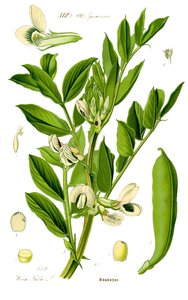
|
Broad Bean |
4-8
Full sun, Partial sun/shade
Moist
Light (sandy), Medium, Heavy (clay)
6.0-6.8
1.0
0.3
Annual
Fast
20cm
Seed - direct sow, Seed - transplant
6 weeks after sowing them in pots
6 weeks after sowing them in pots
21 days
3-5 years
Nitrogen fixer
Leaves, Seed
fava bean, faba bean, Broad bean, or faba bean Varieties with smaller, harder seeds that are fed to horses or other animals are called field bean, tic bean or tick bean Horse bean
Ackerbohne
Fabaceae or Leguminosae
Afghanistan, Iran
Albania, Algeria, Altay, Angola, Argentina South, Assam, Baleares, Bangladesh, Bolivia, Bulgaria, Cameroon, Canary Is., Central European Rus, Chad, China North-Central, China South-Central, China Southeast, Colombia, Corse, Cuba, Cyprus, Czechoslovakia, Dominican Republic, East Aegean Is., East European Russia, Ecuador, Ethiopia, France, Guatemala, India, Iraq, Italy, Jawa, Kenya, Krym, Lebanon-Syria, Leeward Is., Libya, Madeira, Mexico Southwest, Mongolia, Morocco, Myanmar, Nepal, New South Wales, New York, New Zealand North, New Zealand South, Pakistan, Peru, Portugal, Puerto Rico, Rwanda, Sardegna, Sicilia, Spain, Sri Lanka, Sudan, Tibet, Tunisia, Turkey, Turkey-in-Europe, Uruguay, Vermont, Vietnam, West Himalaya, Yemen, Yugoslavia
https://en.wikipedia.org/wiki/Vicia_faba
https://pfaf.org/User/Plant.aspx?LatinName=Vicia faba major
https://powo.science.kew.org/taxon/urn:lsid:ipni.org:names:524737-1
Feb-April; Oct-Nov
sow in deep pots in cool, frost-free place
|
Broad bean (Vicia faba), also known as fava bean or faba bean, is a type of legume that is native to North Africa and the Middle East. It is a popular garden plant, known for its edible beans and attractive purple or white flowers. Broad bean plants have a upright, bushy growth habit and can reach a height of up to 3 feet. The leaves are large and composed of three oval-shaped leaflets, and the flowers are small and clustered in groups of two or three. The beans are produced in long, slender pods that contain two or three beans each. To grow broad beans successfully, it is important to choose a location with well-drained, fertile soil and full sun. The plants should be spaced about 8-12 inches apart, and watered regularly to ensure that the soil stays moist but not waterlogged. Broad beans are generally easy to grow and require little maintenance, but they can be susceptible to pests and diseases, such as aphids and fungal infections. Grows best in temperatures ranging from 60° to 65°F (15-18°C) but will tolerate a range from 40°F (4.4°C) - 75°F (24°C). Broad beans are edible, and the beans can be eaten fresh or frozen, canned or dried for storage. To harvest the beans, the pods should be picked when they are plump and before the beans inside begin to harden. The beans can be removed from the pods by gently squeezing them out. Fresh beans can be stored in the refrigerator for a few days, while dried beans can be stored in an airtight container for several months. In addition to their culinary uses, broad beans also have a number of medicinal properties, and have been used to treat a variety of ailments, including asthma, bronchitis, and anemia. Broad beans are also a valuable food source for many types of wildlife, including birds, insects, and small mammals. The plants provide nectar for bees and other pollinators, and the beans are a popular food for many species of birds. |
Show
Edit |
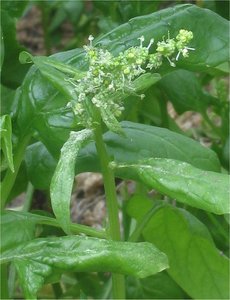
|
Spinach |
4-8
Full sun, Partial sun/shade
Moist
Light (sandy), Medium, Heavy (clay)
0.3
0.3
Annual
Herbs
Fast
Seed - direct sow, Seed - transplant
3 weeks prior to last frost date
2 weeks
Leaves, Seed
Spinat
Chenopodiaceae
Altay, Kazakhstan, Turkmenistan, Uzbekistan
Afghanistan, Algeria, Amur, Bangladesh, California, Canary Is., Cayman Is., Connecticut, Czechoslovakia, Denmark, Dominican Republic, East Aegean Is., Greece, Haiti, India, Inner Mongolia, Iran, Japan, Korea, Kriti, Laos, Lebanon-Syria, Libya, Maine, Marianas, Massachusetts, Morocco, New Hampshire, New York, North Carolina, Norway, Ohio, Oregon, Pakistan, Pennsylvania, Primorye, Rhode I., Saudi Arabia, South Carolina, Sweden, Tadzhikistan, Tunisia, Vietnam, Virginia, Washington, Yemen
https://en.wikipedia.org/wiki/Spinach
https://pfaf.org/User/Plant.aspx?LatinName=Spinacia oleracea
https://powo.science.kew.org/taxon/urn:lsid:ipni.org:names:167384-1
from March to June; Aug to Sep
start seeds indoors 8 weeks prior to last frost date
carminative, laxative, hypoglycaemic; against inflammation
Colouring
Dye
true
|
Spinach (Spinacia oleracea) is a leafy green vegetable native to central and southwestern Asia. The plant has smooth, glossy, and dark green leaves that are arranged in a rosette pattern. It has a long, thick stem that is typically green or red in color, depending on the variety. The plant grows to a height of 6-8 inches and produces small, inconspicuous flowers. Spinach grows best in cool, moist conditions and prefers full sun or partial shade. To cultivate it successfully, the soil should be well-draining and rich in organic matter. The plant can be grown from seed and is typically ready for harvest in about 50-60 days. Successional sowing once per month/every two weeks is recommended for continuous supply. Spinach is highly nutritious and is a good source of vitamins A, C, and K, as well as calcium, potassium, and iron. The edible parts of the plant include the leaves and stems, which can be eaten fresh or cooked. Spinach should be stored in the refrigerator and used within a few days of harvest to maximize its nutritional value. In addition to its culinary uses, spinach has been used medicinally to treat a variety of conditions, including anemia, high blood pressure, and inflammation. The plant can also be used as a fertilizer, as its leaves are rich in nitrogen and other nutrients. Spinach can provide valuable habitat and food for a variety of wildlife, including birds and insects. |
Show
Edit |
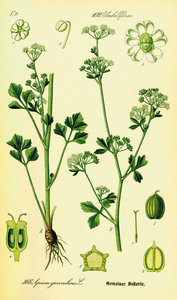
|
Celery |
5-9
Partial sun/shade
Moist
Light (sandy), Medium, Heavy (clay)
0.6
0.5
Annual, Biennial
Herbs
true
Leaves, Root, Seed
Ajwain-ka-patta (indian)
Sellerie
Apiaceae or umbelliferae
Argentina Northeast, Bolivia, Brazil South, Brazil Southeast, Paraguay, Uruguay
https://en.wikipedia.org/wiki/Celery
https://pfaf.org/User/Plant.aspx?LatinName=Apium graveolens
https://powo.science.kew.org/taxon/urn:lsid:ipni.org:names:16467-2
Condiment
Essential Oil, Fragrance
|
Show
Edit |
|
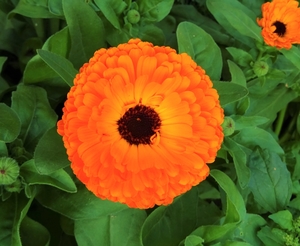
|
Pot marigold |
2-11
Full sun, Partial sun/shade
Moist
Light (sandy), Medium, Heavy (clay)
5.5-7.0
0.6
0.3
Annual
Medium
15cm
6-14 days
21°c (70°f)
60
Compost, Cosmetic, Dye, Essential Oil, Weather forecasting, Dynamic accumulator, Fragrance
Flowers, Leaves
Calendula, Common marigold, Scotch marigold, Ruddles
Ringelblume
Asteraceae or compositae
Spain
Afghanistan, Albania, Argentina Northeast, Argentina Northwest, Argentina South, Assam, Austria, Azores, Baleares, Baltic States, Belarus, Belgium, Bolivia, Borneo, British Columbia, Bulgaria, California, Canary Is., Central European Rus, Chatham Is., Chile Central, Chile North, Chile South, China North-Central, China South-Central, China Southeast, Colombia, Connecticut, Cook Is., Corse, Costa Rica, Cyprus, Czechoslovakia, East Aegean Is., East European Russia, East Himalaya, Ecuador, Ethiopia, France, Germany, Great Britain, Greece, Guatemala, Hainan, Honduras, Hungary, India, Iraq, Ireland, Italy, Jawa, Juan Fernández Is., Kazakhstan, Kriti, Krym, Lebanon-Syria, Lesser Sunda Is., Libya, Madeira, Maine, Malaya, Manchuria, Massachusetts, Mauritius, Mexico Southeast, Michigan, Morocco, Myanmar, Nepal, Netherlands, New Hampshire, New South Wales, New York, New Zealand North, New Zealand South, Newfoundland, North Caucasus, North European Russi, Northern Territory, Northwest European R, Norway, Nova Scotia, Ohio, Ontario, Pakistan, Paraguay, Pennsylvania, Peru, Philippines, Poland, Portugal, Primorye, Qinghai, Queensland, Québec, Romania, Sardegna, Sicilia, South Australia, South European Russi, Sulawesi, Sumatera, Sweden, Switzerland, Tadzhikistan, Taiwan, Tasmania, Tibet, Transcaucasus, Trinidad-Tobago, Turkey, Turkmenistan, Ukraine, Uruguay, Uzbekistan, Victoria, Vietnam, Washington, Western Australia, Wisconsin, Xinjiang, Yugoslavia
https://en.wikipedia.org/wiki/Calendula_officinalis
https://pfaf.org/User/Plant.aspx?LatinName=Calendula officinalis
https://powo.science.kew.org/taxon/urn:lsid:ipni.org:names:187894-1
4.6
Colouring, Tea
true
|
The pot marigold, also known as Calendula officinalis, is a flowering plant probably native to southwestern Asia, western Europe, and the Mediterranean region, however, its long cultivation history makes its precise origin unknown. It is a herbaceous annual plant that typically grows to be about 12-18 inches tall, with hairy stems and leaves. The leaves are lance-shaped, with a hairy surface, and the flowers can range in colour from white through yellow and orange to red and even pink. In terms of growing conditions, the pot marigold prefers well-drained soil and full sun, although it can tolerate partial shade. It is winter hardy, but may not flower as profusely in colder climates. To cultivate it successfully, a grower should plant pot marigold seeds directly in the ground after the last frost of the season. The pot marigold has a number of uses, both culinary and medicinal. The flowers are edible and can be used to add color and flavor to salads and other dishes. The petals can also be dried and used to make tea. In terms of medicinal uses, the plant has been used for centuries to treat a variety of ailments, including wounds, infections, and skin irritation. The pot marigold is also attractive to a variety of pollinators, making it a valuable plant for attracting beneficial insects to the garden. Overall, the pot marigold is a versatile and easy-to-grow plant that is well-suited to a variety of garden settings. ### Propagation - Direct sow Direct sow in spring when light frost is still possible. Can be sown until early summer for fall blooms. ### Propagation - Transplant Sow indoors in late winter, transplant outside when risk of heavy frost has passed. #### Links [Calendula @ West Coast Seeds](https://www.westcoastseeds.com/products/zeolights-organic) |
Show
Edit |
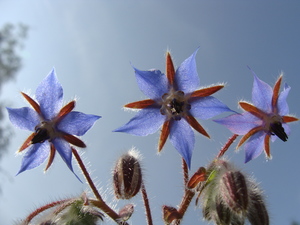
|
Borage |
6-9
Annual
Full sun, Partial sun/shade
Dry, Moist
Light (sandy), Medium, Heavy (clay)
0.6
Herbs
Flowers, Leaves
Seed - direct sow
https://en.wikipedia.org/wiki/Borage
Medium
Common borage, Cool-tankard, Tailwort, Starflower
Boraginaceae
Borretsch
60cm
5-15 days
21°c (70°f)
Oil, Colouring, Tea
https://pfaf.org/User/Plant.aspx?LatinName=Borago officinalis
Borago
5
-2
Algeria, Baleares, Corse, France, Greece, Italy, Kriti, Libya, Morocco, Portugal, Sardegna, Sicilia, Spain, Tunisia, Yugoslavia
Alaska, Alberta, Altay, Argentina Northeast, Argentina Northwest, Argentina South, Austria, Azores, Baltic States, Belgium, Bolivia, British Columbia, Buryatiya, California, Canary Is., Central European Rus, Chile Central, Colombia, Connecticut, Cuba, Cyprus, Czechoslovakia, District of Columbia, Dominican Republic, East Aegean Is., East European Russia, Ecuador, Germany, Great Britain, Guatemala, Haiti, Honduras, Hungary, Illinois, Irkutsk, Jawa, Kamchatka, Kazakhstan, Kirgizstan, Krym, Kuril Is., Lebanon-Syria, Madeira, Maine, Manitoba, Massachusetts, Mexico Central, Mexico Southwest, Michigan, Minnesota, Montana, Netherlands, New Brunswick, New Hampshire, New Jersey, New York, New Zealand North, New Zealand South, Newfoundland, North Caucasus, North Dakota, North European Russi, Northwest European R, Nova Scotia, Ohio, Ontario, Oregon, Pennsylvania, Peru, Poland, Primorye, Prince Edward I., Puerto Rico, Québec, Rhode I., Romania, Sakhalin, Saskatchewan, South European Russi, Switzerland, Tasmania, Tubuai Is., Turkey, Turkey-in-Europe, Turkmenistan, Ukraine, Uruguay, Utah, Vermont, Virginia, Washington, West Siberia, West Virginia, Wisconsin
At last frost
0.3
https://powo.science.kew.org/taxon/urn:lsid:ipni.org:names:113618-1
Dye, oil, Dynamic accumulator
true
|
Borage, also known as Borago officinalis, is a herb native to the Mediterranean region. It is a hairy, annual herb that grows to a height of about 60 cm, with blue, star-shaped flowers and large hairy leaves. The plant is easily differentiated from similar plants by its hairy stems and leaves, and its bright blue flowers. Borage prefers well-drained soil and full sun, and grows best in warm temperatures. It is a fast-growing plant, and can be easily cultivated by direct sowing or transplanting seedlings. Borage is not winter hardy, and should be grown as an annual in most climates. The leaves and flowers of borage are edible, and can be used in salads, soups, and other dishes. The leaves have a cucumber-like flavor, while the flowers are slightly sweet. The edible parts of the plant can be stored by freezing or drying. Borage has several medicinal uses, and has been used traditionally to treat a variety of ailments, including respiratory problems, skin irritation, and anxiety. It is also a good source of nutrients, including calcium, potassium, and vitamin C. In addition to its medicinal uses, borage has value as a companion plant in the garden. It attracts pollinators, such as bees and butterflies, and can be used as a natural pest deterrent. #### Propagation Direct sow early spring when temperatures reach 21°C (70°F). Best sown directly, as borage develops a delicate taproot. #### Links [Borage @ West Coast Seeds](https://www.westcoastseeds.com/products/borage) |
Show
Edit |
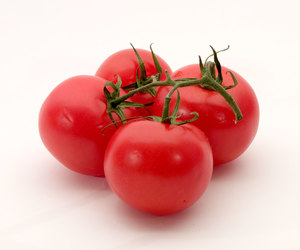
|
Tomato |
10-12
Annual, Perennial
Full sun
Moist
Light (sandy), Medium, Heavy (clay)
2.0
True
Fruit, Seed
https://en.wikipedia.org/wiki/Tomato
Fast
Garden tomato, Dumádu, Garden tomato, Love apple, Lycopersicum esculentum, Tomate, Tomato, Tomato extract containing lycopene, Tomato|thakkali, Tumatis, Lycopersicon esculentum
Solanaceae
Tomate
Oil
https://pfaf.org/User/Plant.aspx?LatinName=Solanum lycopersicum, https://pfaf.org/User/Plant.aspx?LatinName=Lycopersicon esculentum
Start seeds indoors 5-6 weeks before last frost
In containers or in rows in beds around last frost date
6.2-6.8
70-80°f
Peru
Alabama, Alaska, Andaman Is., Angola, Arizona, Arkansas, Assam, Austria, Azores, Bahamas, Bangladesh, Belarus, Benin, Bolivia, British Columbia, Bulgaria, Burkina, California, Cambodia, Cameroon, Canary Is., Cape Verde, Caroline Is., Central African Repu, Chagos Archipelago, Chatham Is., Christmas I., Colombia, Comoros, Connecticut, Cook Is., Costa Rica, Cuba, Cyprus, Czechoslovakia, Delaware, Dominican Republic, East Aegean Is., East European Russia, East Himalaya, Ecuador, Fiji, Florida, Galápagos, Georgia, Gilbert Is., Gulf of Guinea Is., Haiti, Hawaii, Illinois, India, Indiana, Iowa, Ivory Coast, Jawa, Kansas, Kazakhstan, Kentucky, Korea, Laccadive Is., Laos, Leeward Is., Line Is., Louisiana, Madagascar, Madeira, Maine, Malawi, Mali, Marianas, Marquesas, Marshall Is., Maryland, Massachusetts, Mauritania, Mauritius, Michigan, Mississippi, Missouri, Montana, Mozambique, Myanmar, Namibia, Nansei-shoto, Nauru, Nebraska, Nepal, Nevada, New Brunswick, New Caledonia, New Hampshire, New York, New Zealand North, Nicaragua, Nicobar Is., Niue, North Carolina, North Dakota, Nova Scotia, Ogasawara-shoto, Ohio, Ontario, Oregon, Pakistan, Panamá, Pennsylvania, Philippines, Pitcairn Is., Puerto Rico, Québec, Rhode I., Réunion, Saskatchewan, Selvagens, Society Is., South Carolina, South European Russi, Tadzhikistan, Taiwan, Tennessee, Texas, Trinidad-Tobago, Tuamotu, Tubuai Is., Turkey, Turkmenistan, Tuvalu, Utah, Uzbekistan, Venezuela, Vermont, Vietnam, Virginia, Wake I., Wisconsin, Zambia, Zaïre, Zimbabwe
1.00
https://powo.science.kew.org/taxon/urn:lsid:ipni.org:names:316947-2
|
The tomato is a flowering plant native to South America. It is a member of the nightshade family and closely related to the potato. The tomato plant typically grows to a height of 1-3 meters and has a weak, hairy stem. The leaves are arranged alternately on the stem and are typically dark green in color. The plant produces small yellow or white flowers, which develop into the fruit we know as tomatoes. The fruit itself is typically red, but can also be yellow, orange, green, or purple. Indeterminate tomato plants are perennials in their native habitat, but are cultivated as annuals. Determinate, or bush, plants are annuals that stop growing at a certain height and produce a crop all at once. Tomatoes prefer warm, sunny growing conditions and well-drained, humus-rich soil. They can be grown in a variety of soil types, but perform best in soil with a pH between 6 and 6.8. In order to cultivate tomatoes successfully, growers may need to provide support for the plant (such as a stake or cage) to prevent the fruit from weighing down the stem, and may also need to water and fertilize the plant regularly. Tomatoes are generally considered to be frost-sensitive, so in areas with cold winters they may need to be grown in a greenhouse or indoors. There are a great number of cultivars. The edible parts of the tomato plant are the fruit and the leaves. The fruit can be eaten raw or cooked, and is commonly used in a variety of dishes, such as salads, sandwiches, and pasta. The leaves, although not commonly eaten, are also edible and have a slightly bitter taste. After harvest, tomatoes can be stored at room temperature, in a cool place, or in the refrigerator. |
Show
Edit |
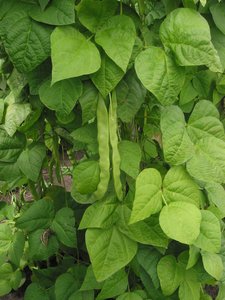
|
Common bean |
2-11
Annual
Full sun
Moist
Light (sandy), Medium, Heavy (clay)
2.0
Vines
Biomass, Dye, antifungal, Nitrogen fixer
true
Leaves, Seed, Seedpod
Seed - transplant, Seed - direct sow
https://en.wikipedia.org/wiki/Phaseolus_vulgaris
Pole bean, Climbing bean, French bean, Bush bean, Dwarf bean, Kidney bean, Green bean
Fabaceae, Leguminosae
Stangenbohne
https://pfaf.org/User/Plant.aspx?LatinName=Phaseolus vulgaris
16-18°c (70-80°f)
6.0-6.8
2.5 cm
16cm
4-10 days
45-85
Fast
Sperzieboon
Costa Rica, Guatemala, Honduras, Mexico Central, Mexico Gulf, Mexico Northeast, Mexico Northwest, Mexico Southeast, Mexico Southwest, Nicaragua, Panamá
Altay, Amur, Andaman Is., Angola, Argentina Northeast, Argentina Northwest, Assam, Baltic States, Bangladesh, Belarus, Bolivia, Bulgaria, Buryatiya, Cameroon, Cayman Is., Central European Rus, Chad, Chita, Colombia, Comoros, Cuba, Czechoslovakia, Dominican Republic, East European Russia, East Himalaya, Ecuador, Ethiopia, Guinea, Gulf of Guinea Is., Haiti, Illinois, India, Iraq, Irkutsk, Jamaica, Jawa, Kazakhstan, Kenya, Khabarovsk, Kirgizstan, Korea, Krasnoyarsk, Kuril Is., Leeward Is., Malaya, Marianas, Maryland, Mongolia, Myanmar, Nepal, New Guinea, New York, Nicobar Is., Nigeria, North Caucasus, North European Russi, Northwest European R, Pakistan, Peru, Philippines, Primorye, Puerto Rico, Queensland, Rwanda, Sakhalin, Senegal, South European Russi, Sri Lanka, Tadzhikistan, Tanzania, Thailand, Togo, Transcaucasus, Trinidad-Tobago, Turkmenistan, Tuva, Uganda, Ukraine, Uzbekistan, Venezuela, Vietnam, Wake I., West Himalaya, West Siberia, Yakutskiya, Zambia, Zaïre
2-4 weeks before last frost
1 week after last frost, 12-14 weeks before first frost
3-5 years
0.4
https://powo.science.kew.org/taxon/urn:lsid:ipni.org:names:514191-1
Coffee, Condiment
|
This entry describes all varieties of the common bean. This includes vining and bush/darf variaties and can have different names depending on their style of growths (see alternate names). These include the kidney bean, the navy bean, the pinto bean, the French bean and the wax bean The common bean, scientific name Phaseolus vulgaris, is a herbaceous annual plant native to the Americas, specifically the regions extending from the southwestern United States to South America. It is a member of the Fabaceae (legume) family. The common bean has a range of different appearances, depending on the variety. Most varieties have a simple, erect stem that grows to a height of 20-60 cm. The leaves are typically green and consist of 3-5 oblong leaflets. The flowers are small and white, pink, or purple in color. The fruit is a legume, which contains the seeds. The common bean is typically a small plant, but some varieties can grow to be quite large, reaching heights of up to 2 meters. The plant grows relatively quickly, with the growing season typically lasting between 60-100 days. The common bean prefers well-drained soil and full sun, but can also grow in partial shade. It is sensitive to frost and should be planted after the last frost date in the spring. To cultivate the common bean successfully, a grower may need to ensure that the soil is adequately fertilized and provide support for the plant to climb, if necessary. The common bean is edible, with the seeds and the young pods being the most commonly consumed parts. The seeds can be cooked and eaten as a protein-rich vegetable, and the young pods can be eaten as a green vegetable. The edible parts can be stored after harvest by drying the seeds or by preserving the young pods in vinegar or oil. The common bean has many uses beyond being a food source. The plant can fix nitrogen in the soil, improving its fertility and making it a useful companion plant for other crops. The dried leaves and stems of the common bean can be used as mulch or as a source of organic matter. In some cultures, the fibers from the stems are used to make ropes or other weaving materials. Additionally, the plant has been used medicinally to treat a variety of ailments. The common bean is also valuable for wildlife. The flowers attract bees and other pollinators, and the plant provides food for a variety of insects, birds, and small mammals. ### Links [Beans Seed Starting Tips @ Harvest to Table](https://harvesttotable.com/beans-seed-starting-tips/) ### Propagation - direct sow Direct-sow beans in spring after all danger of frost has passed and soil is at least 16°C (60°F). In warm-winter regions, sow beans in late summer for harvest in winter. Time sowing so that beans come to harvest before the first frost. |
Show
Edit |
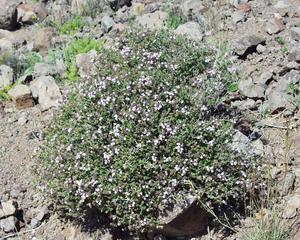
|
Thyme |
5-11
Perennial
Full sun
Dry, Moist
Light (sandy), Medium
Evergreen
0.1-0.3m
Herbs
true
Flowers, Leaves, Shoots
https://en.wikipedia.org/wiki/Thymus_vulgaris
Medium
Garden thyme, Wild Thyme, Samon-phyu, Timo, Tomillo, Thym, Common thyme, German thyme, Thyme
Lamiaceae or Labiatae
Thymian
https://pfaf.org/User/Plant.aspx?LatinName=Thymus vulgaris
Baleares, France, Italy, Spain
Algeria, Belgium, Cuba, Czechoslovakia, Dominican Republic, Haiti, Leeward Is., New Zealand South, Puerto Rico, Switzerland
0.3
https://powo.science.kew.org/taxon/urn:lsid:ipni.org:names:461765-1
Condiment, Tea
Deodorant, Disinfectant, Essential Oil, antifungal, Fragrance, Dynamic accumulator, Ground cover
|
Thyme (Thymus vulgaris) is a perennial herb that is native to the Mediterranean region. It has small, grey-green leaves and tiny, pink or purple flowers. The stems are woody and the plant grows to be about 30 cm tall. Thyme prefers well-drained, sandy soil and full sun. It is a low-maintenance plant and can be grown easily in a garden or in containers. To cultivate it successfully, it is important to water it regularly, especially during dry periods, and to trim the plant regularly to promote new growth. Thyme is edible and both the leaves and flowers can be used in cooking. They can be dried or frozen for long-term storage. The leaves have a strong, pungent flavor and are often used in meat and vegetable dishes, as well as in teas and other beverages. In addition to its culinary uses, thyme also has several medicinal properties. It has been used to treat respiratory conditions, such as bronchitis and asthma, and is also believed to have antibacterial and antifungal properties. It can also be used as a natural insect repellent. Thyme is an attractive plant that is valuable for wildlife. It is a good source of nectar for bees and other pollinators. It is also an important food plant for the caterpillars of some butterfly species. Overall, thyme is a versatile and useful herb that can be grown easily in a variety of conditions. Its flavorful leaves and attractive flowers make it a valuable addition to any garden or farm. |
Show
Edit |
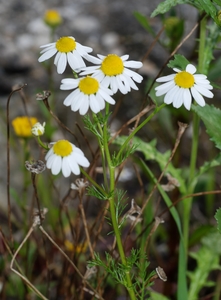
|
Chamomile |
5-9
Full sun
Dry, Moist
Light (sandy), Medium, Heavy (clay)
0.5
0.05
Annual
Herbs
at last frost date
1 week
Matricaria recutita - L., German chamomile, wild chamomile
Kamille
Asteraceae or Compositae
Afghanistan, Albania, Algeria, Altay, Austria, Azores, Belarus, Belgium, Bulgaria, Buryatiya, Canary Is., Central European Rus, China North-Central, China South-Central, China Southeast, Cyprus, Czechoslovakia, Denmark, East Aegean Is., East European Russia, Egypt, Finland, France, Germany, Greece, Hungary, India, Iran, Iraq, Irkutsk, Italy, Kazakhstan, Kirgizstan, Korea, Krasnoyarsk, Kriti, Krym, Lebanon-Syria, Manchuria, Mongolia, Morocco, Myanmar, Netherlands, North Caucasus, Northwest European R, Norway, Pakistan, Palestine, Portugal, Romania, Sardegna, Sicilia, Sinai, South European Russi, Spain, Sweden, Switzerland, Tadzhikistan, Transcaucasus, Turkey, Turkey-in-Europe, Tuva, Ukraine, Uzbekistan, Vietnam, West Himalaya, West Siberia, Xinjiang, Yakutskiya, Yugoslavia
Alabama, Alberta, Arizona, Arkansas, Baleares, Baltic States, Bolivia, British Columbia, California, Colombia, Connecticut, Corse, Costa Rica, Cuba, District of Columbia, Dominican Republic, Ecuador, El Salvador, Ethiopia, Great Britain, Greenland, Guatemala, Gulf States, Honduras, Illinois, Indiana, Iowa, Ireland, Jawa, Juan Fernández Is., Kansas, Kentucky, Magadan, Maine, Mali, Manitoba, Maryland, Massachusetts, Mexico Southeast, Michigan, Minnesota, Mississippi, Missouri, New Jersey, New South Wales, New York, Newfoundland, Nicaragua, North Dakota, North European Russi, Nova Scotia, Ohio, Ontario, Oregon, Paraguay, Pennsylvania, Peru, Poland, Primorye, Québec, Rhode I., Saskatchewan, South Australia, Tennessee, Texas, Tunisia, Uruguay, Utah, Vermont, Virginia, Washington, Wisconsin
https://en.wikipedia.org/wiki/Matricaria_chamomilla
https://powo.science.kew.org/taxon/urn:lsid:ipni.org:names:154715-2
Direct sow in autumn or shortly before latest date of frost
Start seeds indoors 6-8 weeks before last frost date
|
Chamomile is a plant native to Europe, North Africa, and Western Asia. It has a small, daisy-like flower with white petals and a yellow center. The leaves are thin and feathery, and the stem is thin and wiry. Chamomile grows to be about 12-24 inches tall and spreads to about 16-20 inches wide. It grows quickly, producing flowers within a few weeks of germination. Chamomile prefers well-drained soil and full sun to partial shade. It is a hardy plant and can tolerate drought and frost. To cultivate chamomile successfully, it is important to keep the soil moist and well-watered, especially during hot weather. Needs light to germinate. The flowers and leaves of chamomile are edible and can be used in a variety of dishes, including teas and salads. The flowers can also be dried and stored for later use. Chamomile has a number of medicinal properties and has been used to treat a variety of conditions, including anxiety, insomnia, and digestive issues. It is also believed to have anti-inflammatory and antimicrobial properties. In addition to its medicinal uses, chamomile can also be used as a ground cover or as a companion plant in gardens. It can help to repel pests and improve the health of nearby plants. Chamomile is also valued by bees and other pollinators, making it an important plant for maintaining biodiversity in gardens and agricultural areas. #### Links [Chamomile @ Plants For A Future](https://pfaf.org/user/Plant.aspx?LatinName=Matricaria recutita) |
Show
Edit |